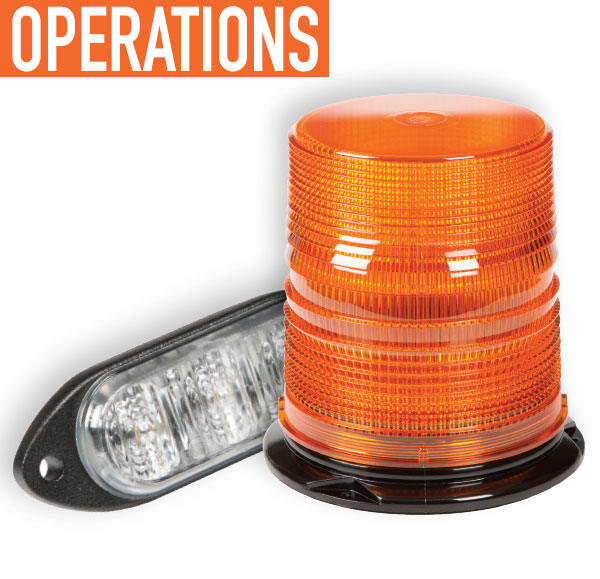To ensure the visibility and safety of everyone on the road, the Society of Automotive Engineers (SAE) mandates that vehicles such as construction, utility, tow, and snowplow trucks are equipped with hazard and warning lights. Whether roof-mounted beacons or directional, surface-mounted to the vehicle’s body or grille, these flashing strobe lights capture the attention of motorists and pedestrians and warn of a potentially hazardous activity or situation.
Available in several colors—amber, white, and blue—and a variety of pulsating strobe effects, these lights come in several SAE classes and mounting styles depending on how quickly the vehicle moves.
Now, however, as the lighting world continues to transition to LEDs, these hazard and warning lights are available in low electrical consumption, long life models that far exceed traditional halogen or gas-discharge options.
THE SWITCH
Making the switch from halogen or gas-discharge to LED lights is even more attractive for fleet managers since the plummeting prices of LED technology, which have decreased to the point that many vehicles requiring Class 2 lights are instead outfitted with brighter Class 1 options given the minimal price differential.
“Today, the entire hazard and warning light industry is undergoing a significant sea change—namely, the industry’s shift to LED technology,” says Chris Cammack of Grote Industries, a US-based manufacturer of vehicle lighting and safety systems that has offered warning strobe lights for more than 20 years, including an array of LED models.
“The reason for this migration comes down to three factors: energy efficiency, longer service life, and brightness,” Cammack adds. “LEDs consume less power than any other lighting technology on the market and are powered by low voltage, allowing for minimal draw of electrical current from the vehicle’s battery.”
By contrast, halogen lights draw an excessive amount of current, which can eventually lead to draining the vehicle’s battery. In addition, they are known for poor energy efficiency, with halogen lights losing as much as 95% of their energy to heat.
Gas-discharge strobe lights are equally inefficient. However unlike halogen lights, it is not due to excessive current draw but instead the intense and concentrated heat generated by the strobe, which can significantly shorten the service life of the flash tube.
LEDs on the other hand consume only 25 to 35% of the power of gas-discharge strobe and halogen lights. As a result, LED strobe lights have a service life that is 10 times longer, often lasting 70,000 hours or more.
With most of the world transitioning to LEDs, the quality of LEDs continues to improve as well. In the early days of LEDs, they were not bright enough to meet SAE requirements for luminous intensity of hazard and warning lights measured in candelas. However technology advanced, and LEDs are now as bright—if not brighter—than the average strobe or halogen light.
“LEDs today are much brighter,” Cammack says. “Today, they are more than bright enough to meet the SAE standard for candela over 100 ft.”
THE COST
Another barrier to early adoption was the initial price point, something else that dramatically changed in the past decade, Cammack says.
“The cost to upgrade to LED strobe lights was prohibitive, at least initially,” Cammack explains. “Fortunately, the prices have come down significantly in the past 10 years, and now they are about the same.”
In fact, Cammack believes LED models will soon become less expensive as fewer manufacturers make models with outdated technology. Companies such as Grote already phased out other technologies in favor of LED only.
“Fewer companies are manufacturing gas-discharged strobe warning lights, so the price of those units is actually going up,” Cammack says. “In a couple of years, it will actually cost more for a gas-discharge or halogen strobe.”
THE OPTIONS
For manufacturers such as Grote, the options are virtually unlimited. The company offers Class 1-3 permanent, vacuum, and magnetically mounted beacon lights in both regular and high profiles and a myriad of strobe patterns. Most of the company’s LED offerings only draw 0.4 to 0.35 amps at 12 VDC.
The company also offers LED directional surface-mount strobes in three-, six-, and 12-diode options that feature 12 different selectable flash patterns in either of two phases, including “steady-on.” These also require only about 0.1 amps per diode.
Twenty-, 30-, and 40-inch LED “traffic directors” with 34 warning flash patterns and five phase options are also available, which are ideal for mounting on front push bumpers, pickup trucks, headache racks, and running board lights.
Cammack adds that it is important when upgrading to LED strobe lights to be cautious when purchasing inexpensive, imported products. Although they may be cheaper initially, some overseas suppliers use lower quality LED components. Moreover, it can become an issue if warranty claims arise.
FOR MORE INFORMATION:
Find out more, visit www.grote.com/warning-hazard or call 800.628.0809.
MODERN WORKTRUCK SOLUTIONS: SEPTEMBER 2018 ISSUE
Did you enjoy this article?
Subscribe to the FREE Digital Edition of Modern WorkTruck Solutions magazine.
![]()





